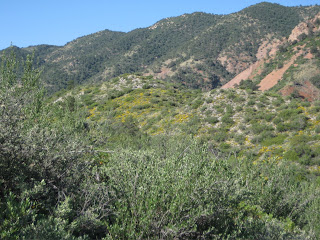When we left Part 1 we were heading toward the Chisos Mountains. Part 2 covers our first day in the Chisos Basin and Mountains.
 As we drove into the Chisos Mountains the desert gave way to grasses, shrubs, and trees as we climbed higher. Up in the highest regions of the Chisos Mountains there are forests. The volcanic origin of the mountains is seen in the massive rock formations.
As we drove into the Chisos Mountains the desert gave way to grasses, shrubs, and trees as we climbed higher. Up in the highest regions of the Chisos Mountains there are forests. The volcanic origin of the mountains is seen in the massive rock formations. Dominating the view in the Basin is Casa Grande, which is indeed a grand sight. This was the view from the porch of our unit in the Rio Grande Motel.
Dominating the view in the Basin is Casa Grande, which is indeed a grand sight. This was the view from the porch of our unit in the Rio Grande Motel. You can see in this picture, which was taken when we were returning from our hike on the Basin Loop, the buildings in the Basin. The rocky hill you can see on the left that is shaped like a pyramid dominates the view from the window of the big dining room in the lodge.
You can see in this picture, which was taken when we were returning from our hike on the Basin Loop, the buildings in the Basin. The rocky hill you can see on the left that is shaped like a pyramid dominates the view from the window of the big dining room in the lodge. From the porch of our unit we could see a cactus wren going in and out of her nest which you can see snuggled into the leaves of this Torrey Yucca (Yucca torreyi).
From the porch of our unit we could see a cactus wren going in and out of her nest which you can see snuggled into the leaves of this Torrey Yucca (Yucca torreyi). David and I spent our first evening at the Basin on the Window View Trail, an easy, short, wheelchair accessible trail that is a cement walkway. There are beautiful views of the window and lots of interesting plants.
David and I spent our first evening at the Basin on the Window View Trail, an easy, short, wheelchair accessible trail that is a cement walkway. There are beautiful views of the window and lots of interesting plants. One of the outstanding plants in the Big Bend basin and mountains this year in mid-August was Damianita (Chrysactina mexicana), which is a short spreading shrub. When it blooms it is covered with flowers. The leaves are dotted with glands and are aromatic when crushed.
One of the outstanding plants in the Big Bend basin and mountains this year in mid-August was Damianita (Chrysactina mexicana), which is a short spreading shrub. When it blooms it is covered with flowers. The leaves are dotted with glands and are aromatic when crushed. When lots of blooming Damianita shrubs are seen together they are spectacular. There were places where whole hillsides were yellow.
When lots of blooming Damianita shrubs are seen together they are spectacular. There were places where whole hillsides were yellow.  Century plants (Agave scabra) are common in the Chisos Basin, and they are spectular plants. They grow for up to 20 years (not really a "century") before reaching maturity. After they bloom, they die. Indians roasted the flowering shoots, leaf-bases, and pods for food.
Century plants (Agave scabra) are common in the Chisos Basin, and they are spectular plants. They grow for up to 20 years (not really a "century") before reaching maturity. After they bloom, they die. Indians roasted the flowering shoots, leaf-bases, and pods for food. When I looked closely at the large leaves of the Century plant, I could see the marks made by the edges of other leaves that were wrapped in the tight new growth when it was much younger, that left the print of their shape in another leaf. I looked for more, and saw that each leaf carries the marks of its neighboring leaves.
When I looked closely at the large leaves of the Century plant, I could see the marks made by the edges of other leaves that were wrapped in the tight new growth when it was much younger, that left the print of their shape in another leaf. I looked for more, and saw that each leaf carries the marks of its neighboring leaves. The hills in this picture are between Ward Mountain (out of the picture on the right) and Emory peak (on the left, also out of the picture). The Yellow on the hillside in the middle is more than likely Damianita.
The hills in this picture are between Ward Mountain (out of the picture on the right) and Emory peak (on the left, also out of the picture). The Yellow on the hillside in the middle is more than likely Damianita. Antelope Horns (Asclepias asperula) is found in the Edwards Plateau, north-central Texas and West Texas. Because it is widespread it is an important plant for the caterpillars of Monarch butterflies.
Antelope Horns (Asclepias asperula) is found in the Edwards Plateau, north-central Texas and West Texas. Because it is widespread it is an important plant for the caterpillars of Monarch butterflies.
No comments:
Post a Comment